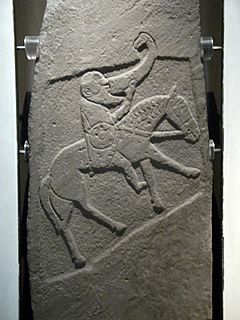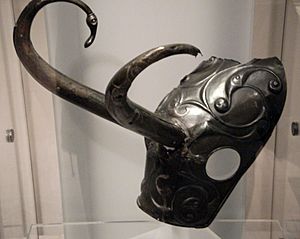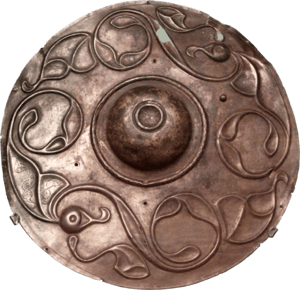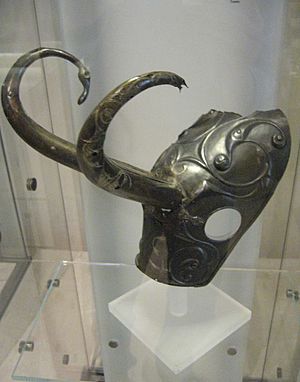Torrs Pony-cap and Horns facts for kids
The Torrs Horns and Torrs Pony-cap are amazing bronze objects from the Iron Age. They are now kept at the National Museum of Scotland. These pieces were found together, but experts still debate how they were originally used.
Most experts agree that the horns were added to the pony-cap later. It's not clear if they were made for this purpose. One idea is that the horns were actually mounts for drinking horns. All three pieces are decorated in a special style called La Tène style, which is how archaeologists describe Celtic art from the Iron Age. These objects are thought to be from around 200 BC. The horns are generally believed to be a bit newer than the cap and have a slightly different style.
No matter their original use or where they were made, these objects are beautifully designed and very skillfully crafted. They are part of a small group of fancy metal items found across Britain and Ireland. These items were made for important leaders in Iron Age society before the Romans arrived.
How They Were Found
The Torrs Horns and Pony-cap were discovered together "about 1820" or "before 1829." They were found in a peat bog at Torrs Loch, near Castle Douglas in Scotland. Finding them in a bog suggests they were a votive deposit, which means they were placed there as an offering.
It was once thought that the horns were separate from the cap when found. However, a newspaper report from that time says they were actually attached. The objects were given by a local historian, Joseph Train, to the famous writer Sir Walter Scott. For a long time, they were displayed with the horns attached at Abbotsford House, Scott's home, which opened to the public in 1833.
Today, the horns are shown fixed onto the cap, pointing backward. But they were originally mounted pointing forward, and have also been displayed separately. A copy of the objects is on display at Abbotsford House.
What They Look Like
The pony-cap has designs made by pushing out the metal from behind, a technique called repoussé. These designs include plant shapes, trumpet-like spirals, and bird heads. The horns have "boldly asymmetric" (meaning uneven but striking) engraved patterns. One horn even has a small human face. The complete horn ends in a sculpted bird head, which some think looks like a northern shoveller duck. This bird head probably had coral eyes at one point. The other horn is missing its tip.
The cap has holes for a pony's ears. The way the cap is displayed now, as seen in the photo, helps show off its decoration. This angle is similar to how the cap would look if a horse were bowing its head. Photos on the museum's website show how it would look when worn normally, with the sides roughly parallel to the ground.
The engraved patterns on the horns are very detailed. Each design starts with a circular "yin-yang" shape, then expands into a main design, and finally tapers into a delicate fan shape. A tiny human face is hidden in the center of the larger horn's design. The pony-cap is about 10.5 inches long, and the complete horn is 16.5 inches along its curve. Because of their size, the horse wearing the cap "would have had to be a very small one." The cap has a large missing piece at the back and three old repairs. These repairs use small decorated plates. In the photo, you can see one repair between the ear hole and the nearby horn.
Art Style and Connections
The horns and cap are important examples of one of the last stages of "Insular" La Tène style in Britain and Ireland. This style is sometimes called "Style IV." Other objects from this period include the Battersea Shield and Witham Shield. A very similar piece is a bronze shield boss found in the River Thames at Wandsworth in London. These three objects are in the British Museum. Experts sometimes call the style of the Torrs and Wandsworth objects the "Torrs-Wandsworth style."
Some experts believe the cap shows a unique "Galloway style" of La Tène art, which is connected to art from northern Ireland. Other experts think these pieces were brought in from other places, perhaps from "east-central England."
What Were They Used For?

The pony-cap is usually thought of as a Celtic version of a champron, which is a piece of horse armour. You might have seen similar armor from the Middle Ages. However, some people think it might have been worn by a human during special ceremonies. This was also the idea of local historians when it was found. In its first description in 1841, it was called a "mummer's head-mask," though they thought it was from the medieval period. The cap would have been held on by leather straps, and a feather plume might have risen from its top.
No other metal champron from ancient times has been found. But there are Celtic and ancient Greek examples made from materials like boiled leather, including one from Newstead Fort in Scotland. Another idea is that the cap was meant for a wooden statue of a horse, which would help explain its small size.
The idea that the horns were mounts for drinking-horns, and never attached to the cap in ancient times, was first suggested in 1955. This idea was popular for about 30 years, and the horns were even displayed separately from the cap. The bird's head on the surviving horn is similar to later examples from early medieval times, like those found in Anglo-Saxon burials (such as Sutton Hoo). These were known or believed to decorate the tips of drinking horns.
However, this theory relied on the idea that the holes and rivets used to attach the horns to the cap were made by a restorer in the 1800s. Later research suggested this was not true. So, experts have "swung back" to supporting the original idea that the horns were attached to the cap. By the late 1960s, some experts thought the horns might have been "yoke-terminals" for chariots. It's still possible that the horns were made for a different purpose but were later attached to the cap before it was buried.
Even though no exact matching finds have been made, some similar objects have been seen in ancient art. For example, a coin of Tasciovanus, an Iron Age chief, shows the mythical horse Pegasus wearing a cap with two knobbed horns. Horse remains found in Iron Age graves of the Pazyryk culture in Siberia were fitted with masks shaped like stag heads with antlers or horns. In July 2015, an Iron Age burial in Dorset, England, was found with a horse's skull that had a cow's horn on its forehead.




